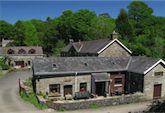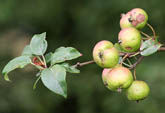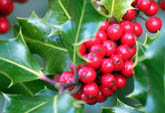Yellow is the prevailing colour of early Spring – wild flowers such as daffodils, primroses and lesser celendine are in abundance and pussy willow catkins attract early bees and butterflies. The Chiffchaff arrives from Africa and many different types of bird may be spotted around the farm, busy building nests to raise their young. See the Welsh holiday weather for March.
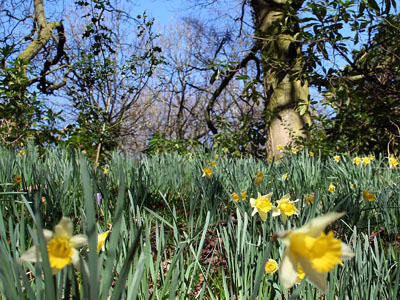
Native Welsh Daffodil Narcissus Pseudoarcissus
The native Welsh daffodil is very rare. It is shorter than the common daffodil but can grow up to six inches tall. It blossoms around the end of March to the beginning of April and has light, pale yellow petals which surround the dark yellow flower. The native Welsh daffodil is also rich in legend and tradition. It is said to be unlucky to bring the Welsh daffodil into the house, as it is considered an insult to the spring. On the other hand, the Welsh daffodil can bring luck to those men who wish to avoid baldness! How and why the daffodil became the national emblem of Wales has been the subject of much debate. Some say that our Victorian ancestors decided that, when it comes to St David's Day, we should pin daffodils to our lapels instead of Wales’s other emblem, the leek. A vegetable wasn't considered glamorous enough to be the Welsh national emblem, and the daffodil, whose flowering coincides with the Welsh patron saint's holiday, seemed like a fitting replacement. The delicate Welsh daffodil is also known as the Lenten lily. The exact flowering dates vary with the weather: a warm spring will prompt the flowers to come out earlier, and global warming seems to be having this effect.Native Welsh Daffodil Narcissus Pseudoarcissus
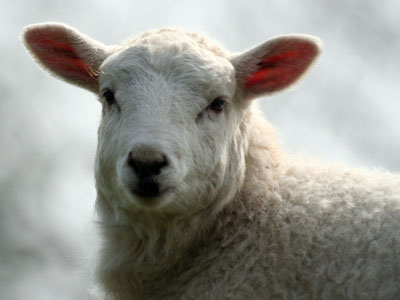
Welsh Mountain Lamb Ovis aries
Welsh lamb is considered by many to be the finest in the world. Plas Farm is mainly grazed by the Welsh Mountain breed whose lambing season begins in the Spring. As March progresses, the fields outside the holiday cottages begin to fill with newborn lambs. Watch them playing from the lawn in front of the cottages as the sun goes down.Welsh Mountain Lamb Ovis aries
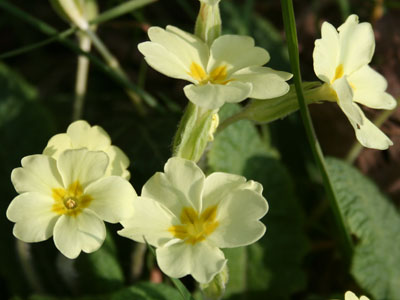
Wild Primrose Primula vulgaris
The 'first rose of Spring'. Primroses, flowering in early March when there are few insects to transfer pollen from one plant to another, successfully set their own seeds. Those that are cross pollinated later by insects produce seeds that are fleshy and sticky. Ants and other foraging creatures attracted by this nutritious 'packaged' food, carry them away, often over great distances. This way Britain's 'prima rosa' is dispersed across the land. The Primrose was used in ancient times to treat paralysis and gout and was believed to be a flower originating in Paradise. The flowers can be made into jam and wine. The five petals represent birth, initiation, consummation, repose and death. Six-petaled Primrose brings luck in love and marriage. There is also a lot of Primrose folklore attached to the ability of Primroses to let people see fairies. If you touch a fairy rock with the right number of Primroses in a posy you will be shown the way to fairyland.Wild Primrose Primula vulgaris
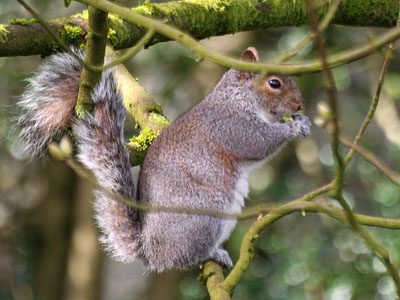
Grey Squirrel Sciurus carolinensis
Grey squirrels, originally from North America, were released in the UK by 19th century landowners. They are now very common and widespread. Grey squirrels are seen every day at Plas Farm, foraging for food in trees and on the ground – even visiting our bird feeders. They are particularly noticeable in March as there are no leaves on the trees and they are very partial to the buds and shoots of sycamore and beech, both of which grow around our holiday cottages. Their nest, called a drey, is a compact, spherical structure. It is slightly larger than a football and constructed of twigs, leaves, bark and grass. Grey squirrels tend to breed in between January and April and, if food is plentiful, they may have a second litter in the summer. They are extremely successful and have replaced our native red squirrels over most of the UK.Grey Squirrel Sciurus carolinensis
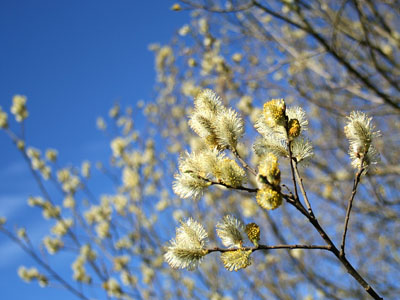
Pussy Willow Salix caprea
Pussy Willow, Goat Willow or Sallow is known for its distinctive catkins that appear in March. Look out for them in the hedgerows that surround the fields around the holiday cottages. The catkins are an important source of nectar for early-flying insects and can also attract numbers of night-flying moths on warm evenings. The leaves of the tree are an important food source for caterpillars. The wood is little used now but in the past it was used for cloth pegs, rake teeth, tool handles etc. It coppices well and trials are looking into its use as a source of fuel.Pussy Willow Salix caprea
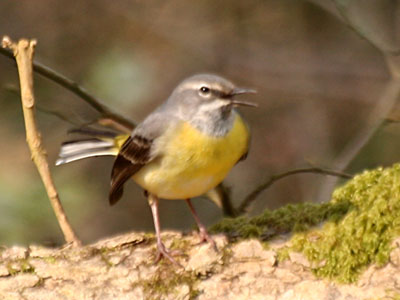
Grey Wagtail Motacilla cinerea
Plas Farm is a great place to see the Grey Wagtail in it's natural environment. They love to nest near shallow, fast-flowing mountain streams and may be spotted in the river and around the farmyard collecting nesting materials and looking for food. The grey wagtail is more colourful than its name suggests with slate grey upper parts and distinctive lemon yellow under-tail. It is the longest tailed of the European wagtails and due to recent declines, is an Amber listed species.Grey Wagtail Motacilla cinerea
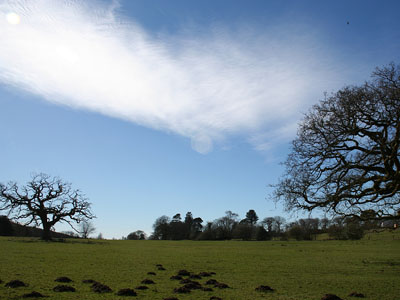
March Landscape at Plas Farm
They say that March comes in like a lion and goes out like a lamb. It is certainly a boisterous month as far as the weather goes but there can be glorious days when air temperatures climb dramatically and beautiful, white clouds move across crystal-clear blue skies such as the day this picture was taken. Mole hills can be seen in the foreground and two magnificent Welsh oaks in the middle distance. The black dot in the top right of the picture is a buzzard.March Landscape at Plas Farm
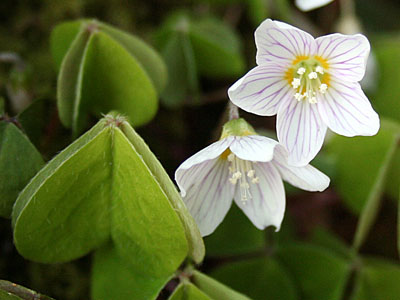
Common Wood Sorrel Oxalis acetosella
Common wood sorrel is one of our earliest flowers. It can be spotted in the woods near to the holiday cottages during March. The flowers are small and white with pink streaks. The binomial name is Oxalis acetosella, because of its sour taste. The leaflets are made up by three heart-shaped leaves, folded through the middle. The stalk is red/brown, and during the night or when it rains both flowers and leaves contract. The common wood sorrel is sometimes referred to as a shamrock (due to its three-leaf clover-like motif) and given as as gift on St. Patrick's Day.Common Wood Sorrel Oxalis acetosella
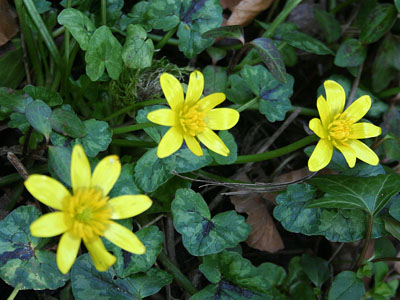
Lesser Celendine Ranunculus ficaria
Lesser Celendine, likes to grow alongside streams and in woods. Also known as the fig buttercup, lesser celendine is arguably the first flower of Spring. Their vivid yellow colour signals that they are ripe with pollen and nectar. It is no coincidence that pollen itself is pigmented yellow. Lesser celendine provides a welcome source of nectar for mice and voles as well as for active insects such as early bees and butterflies.Lesser Celendine Ranunculus ficaria
